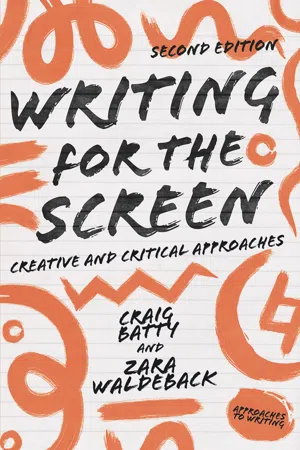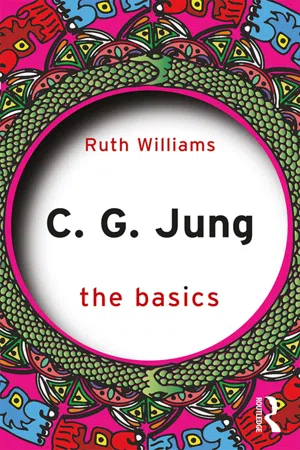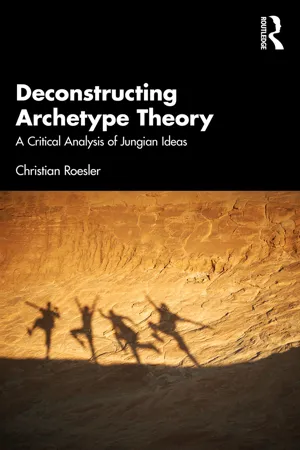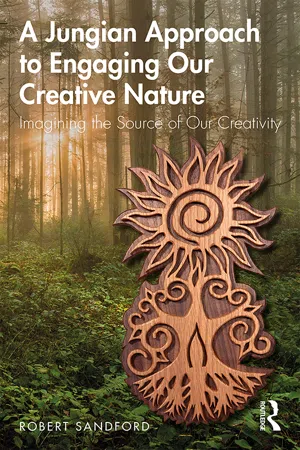Literature
Literary Archetypes
Literary archetypes are recurring symbols, characters, themes, or motifs that embody universal patterns and traits across different cultures and time periods. They serve as fundamental building blocks in storytelling, representing common human experiences and emotions. By tapping into these archetypes, writers can create relatable and resonant narratives that transcend specific cultural or historical contexts.
Written by Perlego with AI-assistance
Related key terms
8 Key excerpts on "Literary Archetypes"
- eBook - ePub
Working with Video Gamers and Games in Therapy
A Clinician's Guide
- Anthony M. Bean(Author)
- 2018(Publication Date)
- Routledge(Publisher)
6ArchetypesWhat Are Archetypes?
Archetypes are considered to be images with universal meanings attached to them (Stein, 1998). They are a widely used and beloved way of experiencing and discussing life, but also one of the most difficult ideas or motifs to conceptualize due to the less than tangible existence they represent. The conceptual idea of these psychologically abstract and literal interpretations of our lives is usually associated with Carl Jung (2014) or James Hillman (2004) as the creators and identifiers of these themes. Archetypes are everywhere, yet have to be conceptualized from a metaphorical, symbolic, and non-literal approach to be used in therapy and commonplace life.The etymology of the word archetype may lend some clarity to its meaning: archetype stems from the Latin noun of archetypum which in actuality is a Latinization, rendering of a non-Latin word to Latin origin, of the Greek noun archetupon (Liddell et al., 1990). Archetupon is a combination of two smaller words: arche and tupos which merge creating the meaning: an original pattern or constellation which all other similar persons, places, objects, concepts, characters, moods, behaviors, ideologies, and many more are derived or modeled after. Therefore, archetypes are the beginning models of all constituted behaviors we observe.What constitutes archetypes are the similarities in which they are presented; they create an analogous thematic form of what is common between multiple scenarios, ideas, behaviors, objects, and images. People viewing them have similar emotions, even when events in which they occur are different. Publicly, we find most archetypes in books, stories, fairytales, and myths (Hillman, 2006,;Jung, 2014). These examples are considered to be the primary beginning stage of archetypes, or the first places to find them in our cultures, across the world. For example, a snowflake is symbolic for winter or air conditioning, while a print of a sun means summer or heat. Similarly, blue is considered conceptually to mean cold, while red is the equivalent to hot. Place these pictures on anything and the person viewing them can understand the representation quite simply. Archetypes are even experienced by individuals across varying cultures and identities. This is what makes archetypes so powerful and exceptional to direct experience; they are commonly felt and experienced across Earth including through the play of video game avatars even though they are within a virtual space (Bean, 2015; Hillman, 2004; Jung, 2014). These patterns can be seen through historical texts, art, religion, fables, myths, and in the case of this book, video game characters. Only by viewing them from this point of reference does one begin to see the importance of how they are intertwined into everyday life, therapy, and psychology. - eBook - ePub
Writing for the Screen
Creative and Critical Approaches
- Craig Batty, Zara Waldeback(Authors)
- 2019(Publication Date)
- Bloomsbury Academic(Publisher)
archetypes of character , a set of universal character types Jung saw as working on an unconscious level and manifesting themselves through everyday stories and culture. For Indick, ‘Whereas the archetypes have been depicted for thousands of years through mythology, religion, legends, stories, and art – the primary instrument for the expression of contemporary archetypes is the modern mass medium of movies’ (2004: xiv); and for Vogler, ‘archetypes are part of the universal language of storytelling, and a command of their energy is as essential to the writer as breathing … Storytellers instinctively choose characters and relationships that resonate to the energy of the archetypes, to create dramatic experiences that are recognisable to everyone’ (1999: 22–30).For the working screenwriter, Jung’s archetypes can have a twofold function: first, they enable a writer to see them in action when analysing existing films and television dramas, where they can understand how they operate; second, the writer can then use this knowledge in character and story creation, assessing the function and status of their characters according to how they may be approached psychologically. In particular, character psychology in relation to character function can help to cast the story, meaning that the writer knows the types of character needed to tell that story.In the book, The Hero with an African Face (1999), Clyde W. Ford argues how vital myth is to human life:Sadly, modern society has lost touch with the power of myth. We now use the word as a synonym for falsehood rather than as an expression of eternal truth … Modern science assures us of the falsehood of myths … Yet read another way, myths are absolutely true: not as fact but as metaphor; not as physics but metaphysics … Myth is interested in the timeless questions of humanity … their answers are best lived, then passed along to those who follow – and that is the mythic route. (1999: 5)The importance of story in our life is not a luxury but an essential. Although it may not seem as key to survival as food, water or oxygen, it has nevertheless been an integral part of human culture for millennia. What is the power of story that makes it so imperative, even in today’s modern society? As master storyteller Joseph Bruchac insists: ‘our stories are alive and we are part of our stories … In the old days, stories were just as important as shelter building, hunting and ceremonies. They taught people about every aspect of the world and also showed the right way to behave’ (2003: 37). Feature films, as well as computer games and virtual reality, allow human beings to enter the mythical realm as much as our ancestors who sat around the fire listening to a storyteller. The full sensory experience that new technology offers means that myth is still powerfully present in our life, and needs to be acknowledged and understood as such. It is both possible and crucial to study the mythical context of these new story technologies and relate to them fully – academically, emotionally and existentially – and listen to their potential not only with our minds but also with our souls. - eBook - ePub
C. G. Jung
The Basics
- Ruth Williams(Author)
- 2018(Publication Date)
- Routledge(Publisher)
3 ArchetypesI will begin by setting out the Jungian definition of archetype. Then I will lightly touch on a few examples with which you will be familiar (although you may not have thought of them in this way), before including some archetypal themes which may not be so immediately obvious, such as number, slavery, love, war, home, sacrifice and meaning.DefinitionArchetype is a precise, technical term in Jungian speech which Jung first coined in 1919 in “Instinct and the Unconscious” (CW8 par. 270). Originally Jung had used the term ‘primordial image’ until he recognised that the manifestations of universal motifs were not limited to images but also arose as ideas, feelings, experiences and characteristic patterns of behaviour (Stevens 2006 p.76).Archetypes are not to be confused with stereotypes. In everyday speech, the meanings are sometimes conflated. A stereotype is used to describe a hackneyed, trite or oversimplified idea/person.Archetypes can be construed as:• significant events (such as birth, death, falling in love, marriage, war)• characters (Mother, Father, Hero, Wise Old Man/Woman etc)• symbols (heart, crucifix, mandalas), and motifs (adolescence, midlife crisis, heartbreak, abandonment, transcendence)Archetypes are not simply intellectual concepts but are imbued with feeling, which gives them their power to affect us in a most visceral fashion. You know when you are gripped by an archetype, such as falling in love. Or when you are possessed by the ‘witch’; or the ‘hero’. They have characteristics with which we may be familiar and encountering them in their archetypal form increases their impact significantly because archetypes are numinous (which means they are possessed of a spiritual quality/energy which increases their force and may be felt as overwhelming).The word ‘archetype’ comes from two Greek words which translate as ‘first pattern’ or prototype. The term as Jung initially envisaged it can be construed as conveying something like a template which then becomes fleshed out with personal/cultural/historical data, creating a more specific/refined image or form. ‘Mother’ is an archetype but our respective cultures will fill this image with greater levels of complexity and nuance, and our personal mothers will create a more specific image of what being a mother means to each of us. Jung: - eBook - ePub
Jungian Literary Criticism
The Essential Guide
- Susan Rowland(Author)
- 2018(Publication Date)
- Routledge(Publisher)
potentials for certain sorts of images, meanings, or patterns of behaviour (Jung 1954a, CW9i: para. 136). Only their images are visible or knowable and these images are never a pure archetype. Rather, similar to an individual literary text re-working inherited forms in a creative union with contemporary elements, so too does the archetypal image evolve particularity from the way universal human inclinations are individually experienced.The various ways Jung chose to express the unknowable nature of archetypes do suggest literary creativity. Archetypes are mysterious personalities wholly independent from the ego (ibid.: para. 80). Alternatively, some archetypes are psychic processes, typical situations or transformations (ibid.). They are not inherited ideas, but rather the inherited possibility for ideas (ibid.: para. 136). The creativity of archetypes is inexhaustible, androgynous, equally capable of any and all genders. Therefore, they may occur in literature as the generative energy that links worlds distant in space, time and culture. For example, the following sixteenth century lines portray a yearning and a peril that is both foreign and recognisable.They flee from me that sometime did me seek With naked foot, stalking in my chamber. I have seen them gentle, tame, and meek, That now are wild and do not remember That sometime they put themself in danger To take bread at my hand; and now they range, Busily seeking with a continual change.(Sir Thomas Wyatt (1503–1542) www.poetryfoundation.org/poems/45589/they-flee-from-me )Here is an archetypal, universal human situation of pain and loss. Where once the speaker was desired, even hunted in his rooms, now the pursuers run away from him. Those who were domestic, wanting a relationship with him are now savage in the sense of having lives no longer attuned to his home. Later lines move from the image of wild animals to the explicitly human, not least in evoking clothes falling off the beloved woman’s body. Part of the archetypal patterning of this poem is the erotics of hunting where what can apply to the stalking of deer is also true for lovers. - eBook - ePub
The American Father Onscreen
A Post-Jungian Perspective
- Toby Reynolds(Author)
- 2021(Publication Date)
- Routledge(Publisher)
These are the patterns which influence our psychological development and growth. They are also the patterns that interact with our culture, our personal experiences and family lives to bring shape and form to an individual psyche. The archetypes are the mechanism through which the psyche maintains its sense of balance and health. (2007, p. 25) Hauke, another leading post-Jungian writer on film, defines the archetype as ‘the unconscious structuring principles of the psyche which make our experience, perception and behaviour distinctly human’ (2001, p. 244). Singh’s discussion and definition of the archetype are directly quoted from Roger Brooke: A hypothetical construct, used to account for the similarity in the images that cluster around typically human themes and situations … anything said about the meaning of an archetypal image, or symbol, is only ever an approximation to this core. (2009, p. 121) This definition is clearly at odds with the more classical view of Stevens, refusing, as it does, to propose the archetype as a solid feature, more a theoretical reaction to existing human behaviour. This divergence of opinion is one of the problems facing anyone attempting to define the archetype as it excites and inspires so many differing views. For my own part, I disagree with Singh and Brooke’s cautious labelling of the archetype as theoretical in that whilst it is an unconscious phenomenon, it can be known, at the very least, by the archetypal images that it produces and the behaviours it generates. Clearly something is present; the fact that it is essentially unknowable apart from the images it creates does not necessarily make it a hypothetical construct. Similar to the Freudian unconscious, it is discernible via the traces it leaves within culture and language. For the purposes of our discussion here, the archetype can be defined as an unconscious but distinct nexus of dynamically essential psychic energy that is located within the collective unconscious - eBook - ePub
Adventure, Mystery, and Romance
Formula Stories as Art and Popular Culture
- John G. Cawelti(Author)
- 2014(Publication Date)
- University of Chicago Press(Publisher)
This is the conception of formula commonly found in those manuals for aspiring writers that give the recipes for twenty-one sure-fire plots—boy meets girl, boy and girl have a misunderstanding, boy gets girl. These general plot patterns are not necessarily limited to a specific culture or period. Instead, they seem to represent story types that, if not universal in their appeal, have certainly been popular in many different cultures at many different times. In fact, they are examples of what some scholars have called archetypes or patterns that appeal in many different cultures. Actually, if we look at a popular story type such as the western, the detective story, or the spy adventure, we find that it combines these two sorts of literary phenomenon. These popular story patterns are embodiments of archetypal story forms in terms of specific cultural materials. To create a western involves not only some understanding of how to construct an exciting adventure story, but also how to use certain nineteenth- and twentieth-century images and symbols such as cowboys, pioneers, outlaws, frontier towns, and saloons along with appropriate cultural themes or myths—such as nature vs. civilization, the code of the West, or law and order vs. outlawry—to support and give significance to the action. Thus formulas are ways in which specific cultural themes and stereotypes become embodied in more universal story archetypes. The reason why formulas are constructed in this way is, I think, fairly straightforward. Certain story archetypes particularly fulfill man’s needs for enjoyment and escape. (I offer some speculations about the psychology of this in chapter 2.) But in order for these patterns to work, they must be embodied in figures, settings, and situations that have appropriate meanings for the culture which produces them - eBook - ePub
Deconstructing Archetype Theory
A Critical Analysis of Jungian Ideas
- Christian Roesler(Author)
- 2023(Publication Date)
- Routledge(Publisher)
autochthonous revival , CW 9/I, 160 and 259–262).Mythological research calls them motifs ; in the psychology of primitives they correspond to Lévy-Bruhl´s concept of representations collectives , and in the field of comparative religion they have been defined by Hubert and Mauss as categories of the imagination .(CW 9/1, 89; also, CW 8, 402; CW 18, 80) The archetype is a preparedness to reproduce again and again the same or similar mythic ideas. (CW 7, p. 109)Archetypes are connected to emotionality
For Jung, the term archetype is strongly connected with the term image; archetypes appear primarily as images. However, as he points out, these images are not abstract but loaded with emotions, which gives them their energy to influence human fantasy production and behaviour (CW 18, 257; CW 9/II, 34; CW 9/I, 4). In this context, he also uses the term numinous to describe the strong emotional impact archetypes can have on a person, meaning both fascinating and intimidating (tremendum et fascinosum). It could be said that archetypes are channels for emotions or psychic energy in general, which give the energy a certain shape and direction.It would be an unpardonable sin of omission were one to overlook the feeling-value of the archetype. This is extremely important both theoretically and therapeutically. As a numinous factor, the archetype determines the nature of the configurational process and the course it will follow, with seeming fore-knowledge, or as though it were already in possession of the goal to be circumscribed by the centring process. - eBook - ePub
A Jungian Approach to Engaging Our Creative Nature
Imagining the Source of Our Creativity
- Robert Sandford(Author)
- 2019(Publication Date)
- Routledge(Publisher)
6THE IDEA OF ARCHETYPES
A mythic tale of origins
As we engage the images in the idea of archetypes, the idea shows itself as a mythic tale of creativity’s origins. The tale paints an imaginal landscape where we can work out our relationship with creativity’s source. Following through on the images and the tale leads us to the union of mortal and immortal in the work, an image which gathers the longing for transcendence and immortality, the binds of inflation and their remedy and leads us through the youthful undoing of what is stuck. In the metaphor of creative piety (of right relations with the source), we reimagine the ‘I’ who creates. This expansion of the one who creates into a multiplicity leads us to the cosmic context of our creativity and the experience of archetypes as autonomous and numinous.The idea of archetypes as an invitation to imagine our creativity
For Jung, the unconsciously activated archetypal image is the creative impetus:The creative process, so far as we are able to follow it at all, consists in the unconscious activation of an archetypal image [or a constellation of archetypal images], and in elaborating and shaping this image into the finished work.(Jung, 1922/1966, p. 82)The archetypal image arises as if from some unknown source and exhibits a relatively autonomous, opaque intent that in retrospect seems to have asserted itself prior to its emergence into consciousness. That intent is simultaneously specific to the image and of the whole psyche (see Jung, 1922/1966, pp. 82–83).The tale of the archetypal image as creative impetus arising from a living unknowable source that calls for a response engages psyche by opening to imagination and the desire for connection. Imagination is our creative mode of relating, so we attend to the idea of archetypes as an invitation to imagine our creativity. Our attention is on the relational value
Learn about this page
Index pages curate the most relevant extracts from our library of academic textbooks. They’ve been created using an in-house natural language model (NLM), each adding context and meaning to key research topics.







